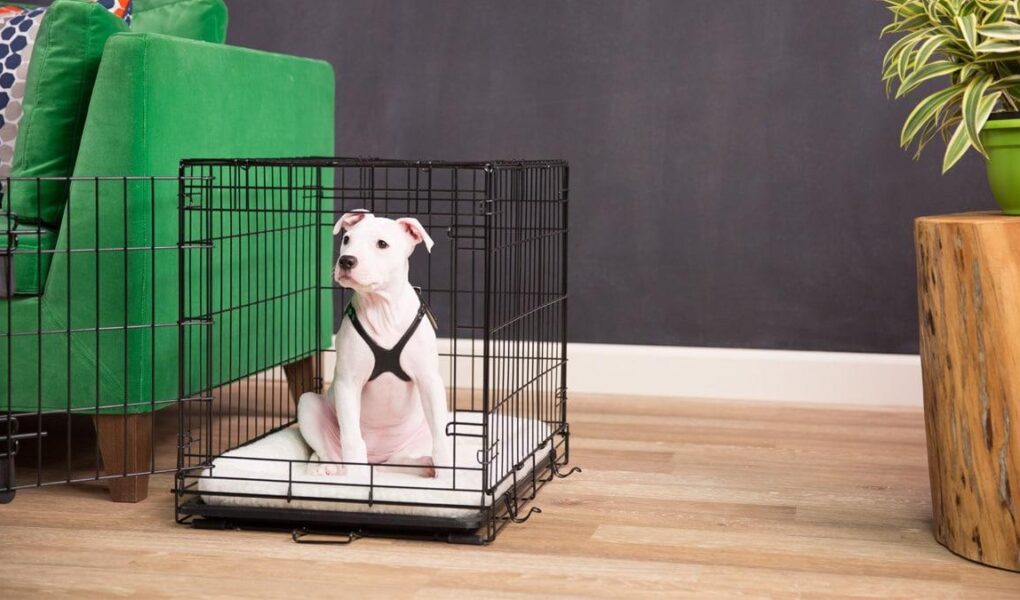Welcoming a new puppy into your home is like bringing a bundle of joy wrapped in fur, but with that joy comes the responsibility of training a curious, energetic little spirit. Among the myriad of training techniques available, crate training stands out as a practical and effective method to foster good behavior while providing your puppy with a safe haven. Imagine your furry companion learning the importance of alone time, mastering the art of potty training, and developing a sense of security, all thanks to a cozy crate. In this article, we will explore the step-by-step approach to crate training your new puppy, debunk common myths, and share tips that will not only ease the transition for your little one but also strengthen the bond between you and your four-legged friend. Whether you’re a first-time dog owner or a seasoned pet parent, the journey toward successful crate training awaits you, filled with patience, understanding, and plenty of wagging tails.
Table of Contents
- Understanding the Benefits of Crate Training for Your Puppy
- Creating a Comfortable and Inviting Crate Environment
- Establishing a Consistent Routine for Successful Crate Training
- Troubleshooting Common Challenges During Crate Training
- Q&A
- Concluding Remarks
Understanding the Benefits of Crate Training for Your Puppy
Crate training offers numerous advantages that extend beyond just housebreaking your puppy. By providing a safe and cozy den-like environment, a crate can help your puppy feel secure, which is particularly important during their initial adjustment to a new home. This method can significantly reduce anxiety and destructive behaviors by giving them a designated space to retreat to when feeling overwhelmed. Additionally, crates can promote better sleep patterns and assist in establishing a routine, as puppies thrive on structure.
Furthermore, crate training can facilitate the bonding experience between you and your puppy. During crate training, you can gradually teach them how to associate their crate with positive experiences. Consider these benefits:
- Safety: Keeps your puppy safe from household hazards when you are unable to supervise them.
- Travel: Makes it easier to transport your puppy in a car, as they will feel secure in their crate.
- Management: Helps manage your puppy’s behavior when guests arrive or if you need them to be in a specific area.
Creating a Comfortable and Inviting Crate Environment
Creating a cozy and welcoming space for your new puppy within their crate is essential for successful crate training. Start by selecting a crate that is appropriately sized—enough for your pup to stand up, turn around, and lie down comfortably. To make the crate feel more like a den, consider adding some soft bedding. A plush blanket or a fitted crate mat not only enhances comfort but also gives your puppy a sense of security. You can also include a few of their favorite toys to keep them entertained and encourage them to see the crate as a positive space, not a confinement. Remember to rotate the toys occasionally to maintain interest.
Temperature and ambiance play a crucial role in your puppy’s comfort as well. Position the crate in a quiet area of your home where the puppy can feel safe but still be part of family activities. Avoid placing it in high-traffic zones or overly noisy environments. Ensure proper ventilation, and keep the area well-lit without excessive brightness. To further enhance the crate’s inviting nature, you might consider using a crate cover for a more den-like atmosphere. Here are some helpful tips to remember:
- Use a crate pad or blanket: For warmth and comfort.
- Incorporate familiar scents: Place an item of your clothing in the crate.
- Keep a consistent feeding area: Feed them near the crate to build a positive association.
Establishing a Consistent Routine for Successful Crate Training
To ensure your puppy feels at home in their crate, consistency is key. Establish a regular schedule that aligns with their natural behaviors and needs. This includes setting specific times for meals, play, bathroom breaks, and crate sessions, allowing your puppy to acclimate to a predictable routine. By following a pattern, your puppy will learn when to expect time in the crate and when they can enjoy activities outside it. Consider the following practices for crate training success:
- Feeding Times: Offer meals at the same time each day to help regulate bathroom needs.
- Play Sessions: Engage in energetic playtime to tire your puppy out before crate time.
- Puppy Potty Break: Always take them out to relieve themselves before going into the crate.
- Quiet Time: Gradually increase the duration your puppy spends in the crate while you’re home.
Moreover, incorporating positive reinforcement can significantly enhance your puppy’s perception of the crate as a safe haven. Use treats and praise to create positive associations, rewarding them when they enter the crate voluntarily. Over time, you’ll want to extend the duration they stay inside without fuss. Here’s a simple guide to help you track progress and establish your puppy’s comfort level with the crate:
| Duration in Crate | Reward | Notes |
|---|---|---|
| 5 Minutes | Treat and praise | Observe comfort level |
| 15 Minutes | Treat, praise, and calming voice | Begin to close crate door briefly |
| 30 Minutes | More treats upon exit | Keep crate door closed longer |
| 1 Hour+ | Extended praise and playtime | Focus on positive experiences |
Troubleshooting Common Challenges During Crate Training
Crate training is a fantastic way to help your new puppy feel secure and understand boundaries. However, it can come with its own set of challenges. One common issue is when puppies cry or whine when placed in their crate. This behavior can stem from separation anxiety or simply a desire for companionship. To address this, consider the following strategies:
- Gradual acclimatization: Start by letting your puppy explore the crate with the door open.
- Short durations: Initially confine them for brief periods, gradually increasing the time.
- Positive reinforcement: Reward them with treats or praise when they enter the crate calmly.
Another challenge might be house-training mishaps while using the crate. Puppies might not fully understand that they should avoid soiling their sleeping area. To minimize these accidents, ensure that the crate is appropriately sized; it should be large enough for the puppy to stand, turn around, and lie down, but not so spacious that they can designate a corner for bathroom use. Here’s a simple guideline:
| Age of Puppy | Crate Size |
|---|---|
| 2-3 Months | Small Crate (24-30 inches) |
| 4-6 Months | Medium Crate (30-36 inches) |
| 6+ Months | Large Crate (36-42 inches) |
Q&A
Q&A on Crate Training a New Puppy: A Guide to Success
Q1: What is crate training and why is it important for my puppy?
A1: Crate training involves teaching your puppy to view their crate as a safe and comfortable space. It is important because it helps with housebreaking, provides a secure den-like environment, and keeps your puppy safe when you’re unable to supervise them. A well-trained puppy will learn to enjoy their crate, making travel and vet visits much easier.
Q2: When should I start crate training?
A2: Ideally, crate training should begin as soon as you bring your new puppy home. Puppies, as young as 8 weeks old, can start acclimating to their crate. Starting early helps them form positive associations with the crate and encourages quicker adaptation.
Q3: How do I choose the right crate for my puppy?
A3: Select a crate that is appropriate for your puppy’s size; they should be able to stand up, turn around, and lie down comfortably. You might consider a crate with a divider so you can adjust it as your puppy grows. However, avoid getting one too large, as puppies may use one corner as a bathroom rather than keeping their sleeping area clean.
Q4: How can I make the crate inviting for my puppy?
A4: To make the crate a cozy retreat, place soft bedding and a few of your puppy’s favorite toys inside. You can also leave the crate door open at times to encourage exploration. Adding treats occasionally can further entice your puppy to enter willingly, creating positive associations.
Q5: What are some best practices for introducing my puppy to the crate?
A5: Introduce the crate gradually. Start by leaving the door open and allowing your puppy to explore at their own pace. Reward them for entering the crate with treats and praise. Avoid shutting the door initially, and only do so once your puppy is comfortable. Keep the initial crate sessions short, gradually increasing the time as they adapt.
Q6: How long can I leave my puppy in the crate?
A6: Young puppies have limited bladder control. A general rule of thumb is that they can hold it for about one hour for every month of age (up to around 6 months). For example, a 2-month-old puppy shouldn’t be crated for more than two hours. Always ensure they have ample time outside of the crate for potty breaks, exercise, and socialization.
Q7: What should I do if my puppy cries or whines in the crate?
A7: It’s common for puppies to cry at first as they adjust. If they whine, assess whether they may need to go outside. If it’s not a potty issue and they’re simply seeking attention, avoid giving in immediately; instead, wait until they settle down. Consistency is key, and over time, they will learn to feel secure in their crate.
Q8: How can I use crate training to help with house training?
A8: Using a crate effectively can accelerate house training. Puppies naturally avoid soiling their sleeping area, so restricting their space helps them develop bladder control. Take your puppy out promptly after they’ve been in the crate to reinforce the connection between being inside and going outside.
Q9: Are there any pitfalls I should avoid during crate training?
A9: Yes, avoid using the crate as a form of punishment or leaving your puppy confined for extended periods. Your crate should be a positive space, not a source of fear or distress. Ensure that the crate remains a comfortable and safe environment to foster trust with your puppy.
Q10: How long will it take for my puppy to be fully crate trained?
A10: Every puppy is different, but with consistent training and positive reinforcement, most puppies adapt to their crates within a few weeks. Patience is key—as you continue to reinforce the benefits of the crate, your puppy will come to view it as their safe haven.
By following these guidelines and remaining patient, you will see the many benefits of crate training unfold, making your journey as a pet owner even more rewarding.
Concluding Remarks
As you embark on the rewarding journey of crate training your new puppy, remember that patience and consistency are your best allies. This process is not just about teaching your furry friend to enjoy their cozy space; it’s also about fostering a sense of security and trust between you both. Celebrate the small victories, like those first moments of calm in their crate, or the joyous wag of their tail as they realize their space is a safe haven. With time, understanding, and a sprinkle of love, your puppy will not only learn to embrace their crate but will also thrive in the stability it brings to their new life. So, equip yourself with the knowledge and tools you need, and embark on this journey with an open heart. Every wag, bark, and snuggle will be worth it as you and your puppy build a bond that will last a lifetime. Happy training!



